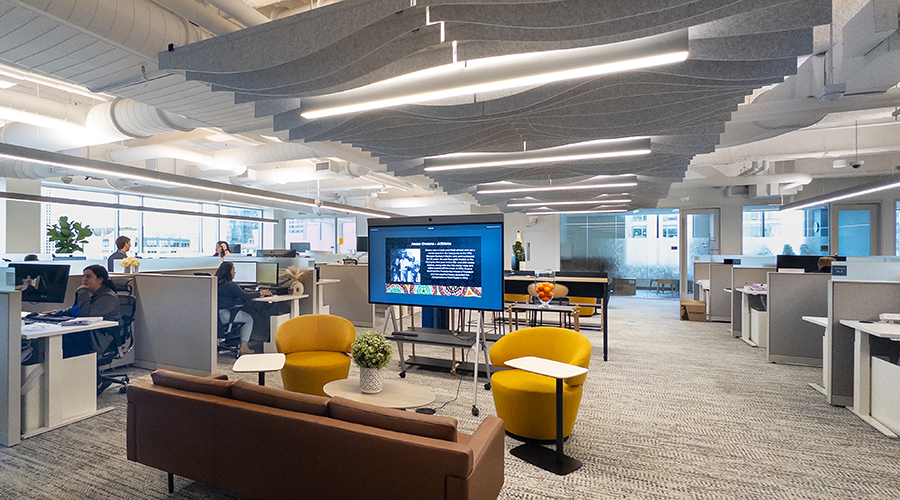Facing Future: Strategies for the Next Generation Office
A new report from Urban Land Institute takes the pulse of occupants and landlords to identify priorities, best practices, and future plans for the ever-shifting office environment.
By Greg Zimmerman, senior contributing editor
It’s not exactly going out on a limb to state that the nature of the traditional office environment is changing. The change was all at once because of Covid, and now more gradual as we continue to emerge from the pandemic and organizations are testing and gathering data on hybrid work, reduced real estate footprints, and other new theories of office strategy.
The Urban Land Institute recently published a new report on the future of the office, the landlord/tenant relationship, and other peripheral issues related to how workers will interface with office space going forward. The report, titled “Bridging the Occupier-Landlord Gap for the Future of Workspace,” found there is much room for improvement in the current state of the office. Only 14 percent of occupants reported that their current space aligns with business objectives, according to the report. That’s less than ideal.
Occupants reported that their top three priorities for office space are employee productivity, increasing employee utilization of existing office space, and reducing costs. That’s probably not an earth-shattering revelation for facility managers. But it confirms many of the ongoing post-pandemic trends: Employees want space that helps them get work done and with perks they can’t get working from home. It’s up to facility managers these days to identify ways to provide these benefits in their space.
We recently spoke with Simon Chinn, vice president, research and advisory services, for Urban Land Institue Europe, who helped spearhead the recent study. Chinn discusses the future of the office and offers advice on some best practices found in through ULI’s research on how facility managers can tailor space to new trends and new occupant asks.
FacilitiesNet: The prevailing wisdom is that the office needs to be enticing, to encourage workers to come back, to give them something they can't get working at home. What are some ways facility managers should consider scaling up their facilities, beyond the sort of "traditional" perks like free coffee?
Simon Chinn: Offices need to think about promoting/incorporating mixed-use space and how multipurpose spaces can provide a range of activities under one roof besides just office-use, this encompasses more than just "traditional" perks like free coffee to include a broader set of facilities and services such as showers, bike storage due to increased demand from occupiers for active transport facilities. Space needs to be adapted to suit a range of different working habits such as more collaboration spaces, quiet spaces for concentration, and separate rooms for private calls etc.
Offices should consider ESG compliance as tenants are increasingly becoming more attracted to office space that promotes sustainability (in all aspects – environmental, socially, and economically). Many companies worldwide are trending towards ESG benchmarks, the desire to have tangible examples (ex. working in an ESG compliant building) of how they are doing so is important to talent attraction, public appearance, and utilities cost.
Consider flexible leases for office space that better accommodates hybrid/flex workers.
Increased connectivity, the ability to get to the office remains an important factor still as transit-oriented office development, is in high demand due to convenience and carbon footprint awareness.
FacilitiesNet: If facility managers need to downsize or repurpose space, what are some best practices for doing so?
Simon Chinn: Repurposing space with amenities (gyms, food/coffee shops, lounge nooks, etc.) is an attractive option for facility managers due to their ability to enhance office space.
Adoption of flexible space is a great alternative to repurposing space as this option allows facility managers to change floorplans to fit the needs of various tenants.
FacilitiesNet: How should strategies geared toward occupant health and wellness feature in the future of the office?
Simon Chinn: Promote adaptable spaces and services that are geared towards health and openness. Offices that foster anti-social design features (ex. Cubicles) and poor in-house food amenities are increasingly less desirable as they run the risk of not incorporating new health value drivers such as in-house gyms or quality food options.
Gamify healthy behaviors by offering tenants incentives to choosing the stairs over the elevator (measured via an app) or provide in-house food loyalty programs that give people a reason to continue eating at a healthy, in-house food establishment.
Incorporate wellness technology into the fabric of the building that sustains optimal temperatures throughout the year as well as improves/supports air quality.
FacilitiesNet: In total, where do you see the future of the office building headed? What are some major long-term trends facility managers should keep in mind?
Simon Chinn: Flexibility is key, over half of the landlords surveyed for this report said they would increase investment in flexible or co-working spaces over the next five years. Office real estate will need to become more agile and flexible to accommodate the growing trend towards activity-based modes of working (and office lease length expectations).
ESG compliance is not going away. Offices need significant capital expenditure to bring buildings up to occupier demand and ESG standards. This will be a key selling point in retaining/attracting tenants who are likely looking for Class A Prime office space that is congruent with their ESG standards. Moreover, monitoring technology will become the norm for future office buildings as it is a key value driver in energy efficiency.
The hollowing out of office space witnessed after the pandemic has created a competitive market for landlords where offering health promoting amenities, complying with ESG standards, and compromising on shorter lease terms to accommodate activity-based modes of working has left many landlords with two options: actively adapt or have an empty office asset. The age of remote and hybrid working is here to stay and in many parts of the world, office space is in oversupply. This means landlords will need to actively incorporate new value drivers into their assets that are often costly and that require active ownership (ex. less emphasis on office size and more emphasis on energy efficiency/flexible working).
The growth of non-conventional income streams for landlords will continue to rise due to scaling down and repurposing space. This can take any form ranging from landlord-owned cafes to landlords becoming utility providers for multiple office assets that traditionally would have been provided by external utility companies.
Greg Zimmerman is senior contributor editor for the facility group, which including FacilitiesNet.com and Building Operating Management magazine. He has more than 19 years’ experience writing about facility issues.
Related Topics:












